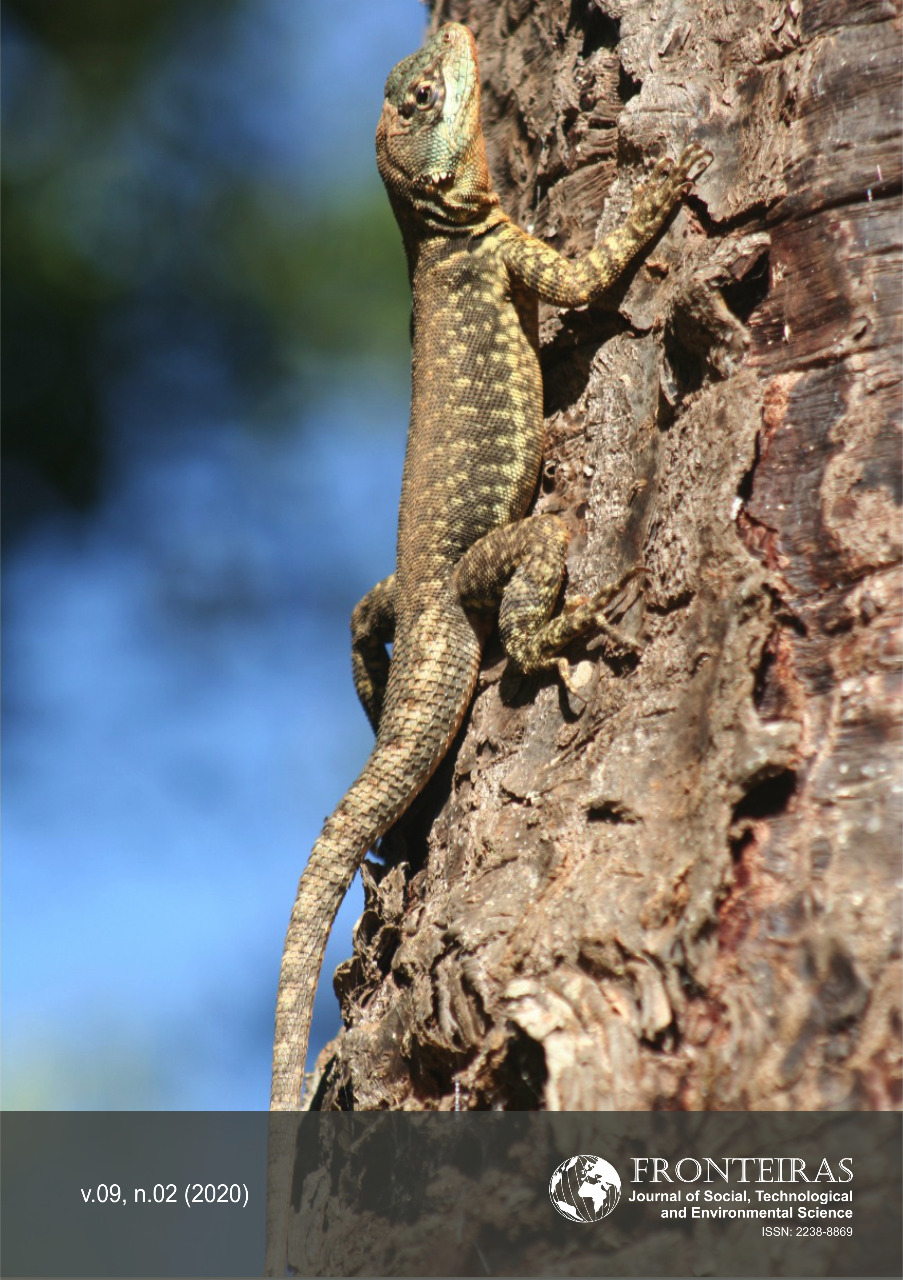Development, Characterization and Stability of Bacaba Peel Extract Microemulsion Systems
DOI:
https://doi.org/10.21664/2238-8869.2020v9i2.p88-102Palabras clave:
Bacaba, Stability Study, MicroemulsionResumen
Bacabeira (Oenocarpus bacaba MART.), a palm tree native from Amazon, has flavonoids found in its fruit peel with antioxidant activity, interesting to incorporate and stabilize in formulations in order to create drug vehicles with advantages. Thus, the aim of this work was to incorporate bacaba peel extract in microemulsions to assess its stability. All formulations contained pre-established quantities of distilled water, capric/caprylic triglycerides, Span 80® and Tween 80®, with 5 % of extract at 0.1 g mL-1 added. From the 72 tested formulations, eight produced microemulsions and were subjected to centrifugation, physicochemical characterization and stability studies, with four sustaining their physical stability. All samples showed Newtonian profile and linear viscosity. The droplets size did not exceed 325 nm of hydrodynamic diameter. Test for antioxidant activity showed satisfactory. Therefore, it was possible to develop microemulsions from peel bacaba with stability that is suitable for their use as drug vehicles.
Citas
Araújo JMA 2011. Química de Alimentos: teoria e prática. Fifth Edition. UFV, Viçosa, 601 pp.
Boonme P, Krauel K, Graf A, Rades T, Junyaprasert VB 2006. Characterization of microemulsion structures in the pseudoternary phase diagram of isopropyl palmitate/water/Brij 97:1-butanol. AAPS PharmSciTech. 7: E99-E104.
Bumajdad A, Eastoe J 2004. Conductivy of water-in-oil microemulsions stabilized. J Colloid Interf Sci. 274: 268–76.
Canuto GAB, Xavier AGO, Neves LC, Benassi MT 2010. Caracterização Físico-Química de Polpas de Frutos da Amazônia e Sua Correlação Com a Atividade Anti-Radical livre. Braz J Fruti. 32: 1196-1205.
Constantinides PP, Yiv SH 1995. Lipid Microemulsions for Improving Drug Dissolution and Oral Absorption: Physical and Biopharmaceutical Aspects. Int J Pharm. 115: 225-234.
Cotrim AC de M, Honorio-frança AC, França EL 2016. Rheology analysis can be added in thermal stability test for design microemulsion materials. Biointerface Res. Appl. Chem. 6:1128–36.
Date AA, Naik B, Nagarsenker MS 2006. Novel drug delivery systems: potential in improve/ng topical delivery of antiacne agents. Skin Pharmacol Physiol.19:2–16.
Elmasta M, Gulçin I, Isildak O, Küfrevio Ö, Ibaoglu K & Aboul-enein HY 2006. Chemical Society Radical Scavenging Activity and Antioxidant Capacity of Bay Leaf Extracts. J Irananian Chem Soc. 3: 258-266.
Escriche I, Restrepo J, Serra JÁ, Herrera LF 1999. Composition and nutritive value of Amazonian palm fruits. Food Nutr. Bul. 20(3): 361-364.
Fanun M 2012. Microemulsion as delivery systems. Curr. Opin. Colloid Interface Sci. 17: 306-313.
Finco FDB, Kammerer DR, Carle R, Tseng W, Böser S, Graeve L 2012. Antioxidant activity and characterization of phenolic compounds from bacaba (Oenocarpus bacaba Mart.) Fruit by HPLC-DAD-MS. J Agr Food Chem. 60: 7665-7673.
Fiori KP, Torres MPR, Schons JI, Ribeiro EB, Nogueira RM, Vasconcelos LG, Andrighetti CR, Jacinto MJ, Valladão DMS 2017. Microemulsion of Brazil Nut Oil as a Natural Product to Improve Superoxide Release in Human Phagocytes. Quím Nova. XY: 1-7.
Fontes IRC 2009. Escurecimento Enzimático em Frutos: Polifenoloxidase de Atemóia (Annona cherimola Mill. X Annona squamosa L.). Masters dissertation. Universidade Estadual Paulista, Araraquara, 119f.
Fryd MM, Mason TG 2012. Advanced Nanoemulsions. Annu Rev Phys Chem. 63: 493-501.
Gustmann PC, Cotrin ACM, Pires EM, Andrighetti CR, Valladão DMS Ribeiro EB 2017. Development of Brazil nut oil microemulsion as vehicle for Levamisole. J Applied Pharmac Sci. 7 (08): 92-98.
Kumar A, Kushwaha V, Sharma PK 2014. Pharmaceutical Microemulsion: Formulation, Characterization and drug deliveries across skin. Int. J. Drug Dev. Res. 6(1): 1-21.
Lawrence MJ, Rees GD 2012. Microemulsion-based media as novel drug delivery systems. Adv Drug Deliver Rev. 64: 175-193.
Leanpolchareanchai J, Padois K, Falson F, Bavovada R, Pithayanukul P 2014. Microemulsion System for Topical Delivery of Thai Mango Seed Kernel Extract: Development, Physicochemical Characterisation and Ex Vivo Skin Permeation Studies. Molecules. 19: 17107-17129.
Li WJ, Cheng XL, Liu J, Lin RC, Wang GL, Du SS, Liu ZL 2012. Phenolic compounds and antioxidant activities of Liriope muscari. Molecules. 17: 1797-1808.
Nichols JA, Katiyar SK 2010. Skin Photoprotection by natural Polyphenols: Anti-inflammatory, Antioxidant and DNA machanisms. Arch Dermatol Res. 302: 71-83.
Oliveira DA, Moreira PA, Melo Junior AF, Pimenta MAS 2006. Potencial da biodiversidade vegetal da Região Norte do Estado de Minas Gerais Unimontes Científica. 8(1): 23-33.
Panapisal V, Charoensri S,Tantituvanont A 2012. Formulation of Microemulsion Systems for Dermal Delivery of Silymarin. AAPS PharmSciTech. 13: 389-399.
Ribeiro EB, Kelly P, Lanes D, Galdeano N, Chaud A, Pessoa RS, Honorio-frança AC, França EL 2015. Microemulsions with Levamisole Delivery Systems as Novel Immunomodulating Agents with Potential for Amebiasis Therapies. Sci. Adv. Mater. 7: 15–27.
Silva MLC, Costa RS, Santana AS, Koblitz MGB 2010. Compostos fenólicos, carotenóides e atividade antioxidante em produtos vegetais. Revista Semina: Ciências Agrárias. 31(3): 669-682.
Sousa KA, Santoyo AH, Rocha Junior WF, Matos MR, Silva AC 2016. Bioeconomia na Amazônia: uma análise dos segmentos de fitoterápicos & fitocosméticos, sob a perspectiva da inovação. J Soc Tech Eviron Sci. 5: 151-171.
Svobodová A, Psotová J, Walterová D 2003. Natural Phenolics in the Prevention of UV-induced Skin Damage. A review. Biomed. Papers. 147: 137-145.
Teixeira LN, Stringheta PC, Oliveira FA 2008. Comparação de métodos para quantificação de antocianinas. Revista Ceres. 55: 297-304.
Tiuman TS, Santos AO, Ueda-Nakamura T, Dias Filho BP, Nakamura CV 2011. Recent advances in leishmaniasis treatment. Int J Infect Dis. 15: 525-532.
Zorzi GK, Caregnato F, Moreira JCF, Teixeira HF, Carvalho ELS 2016. Antioxidant Effect of Nanoemulsions Containing Extract of Achyrocline satureioides (Lam) D.C.-Asteraceae. AAPS Pharm Sci Tech. 17 (4): 844-850.
Descargas
Publicado
Cómo citar
Número
Sección
Licencia
Esta revista oferece acesso livre imediato ao seu conteúdo, seguindo o princípio de que disponibilizar gratuitamente o conhecimento científico ao público proporciona maior democratização mundial do conhecimento.
A partir da publicação realizada na revista os autores possuem copyright e direitos de publicação de seus artigos sem restrições.
A Revista Fronteiras: Journal of Social, Technological and Environmental Science segue os preceitos legais da licença Creative Commons - Atribuição-NãoComercial 4.0 Internacional. 

